Performance Evaluation of Graph Neural Network-Based RouteNet Model with Attention Mechanism
Abstract
1. Introduction
- Enhancement of the RouteNet model internal architecture by incorporating the attention mechanism, enhancing its delay prediction.
- Evaluation of the predictive capabilities of the original RouteNet with the attention-enhanced version.
2. Background and Related Work
2.1. RouteNet Model
- where
- : Learnable weight matrices used to capture patterns in the input data.
- : Input at time step t in the sequence.
- : Previous hidden state at time step .
- : Sigmoid function used for activation and gate control.
- : Reset gate output at time step t, determines previous state reset.
- : Update gate output at time step t, controls new information incorporation.
- : Candidate hidden state at time step t, computed using the reset gate and input.
- : Current hidden state at time step t, computed by combining the previous hidden state and the candidate hidden state based on the update gate.
2.2. Related Work
3. Methodology
- Topology: The input topology represents the network structure using a directed graph, where nodes represent network devices (such as routers or switches) and edges represent physical or logical links connecting these devices. Moreover, topology includes properties such as nodes, links, queue sizes, and link capacity. It provides a detailed description of the physical objects in the network and their interconnections, enabling the model to understand the network’s layout and properties.
- Traffic Matrix: The traffic matrix is a matrix representation where the rows and columns correspond to network devices, and the elements indicate the bandwidth or volume of traffic between device pairs. This input provides information about the flow-level and aggregate characteristics of network traffic, including metrics such as average bandwidth, packet generation rates, and average packet size. Analyzing the traffic matrix allows the model to simulate and analyze the traffic patterns and demands within the network, facilitating resource allocation and capacity planning.
- Routing: The routing input consists of a scheme that specifies the paths connecting source–destination pairs in the network. It defines the routes that packets take when traveling from one node to another. By analyzing the routing scheme, the model can evaluate the efficiency and effectiveness of data routing, allowing for optimizations and informed decision making regarding network traffic distribution.
3.1. RouteNet Model Implementation
3.2. RouteNet Model with Attention
3.3. Detailed Internal Architecture of RouteNet with Attention
| Algorithm 1: Internal Architecture of RouteNet Model with Attention |
 |
3.4. Modified RouteNet with Stacked RNN and Sequential Link Update
3.5. Modified RouteNet Model with Attention
4. Results and Discussion
Results Analysis
5. Conclusions and Future Work
Author Contributions
Funding
Data Availability Statement
Acknowledgments
Conflicts of Interest
References
- Ferriol-Galmés, M.; Suárez-Varela, J.; Rusek, K.; Barlet-Ros, P.; Cabellos-Aparicio, A. Scaling graph-based deep learning models to larger networks. arXiv 2021, arXiv:2110.01261. [Google Scholar]
- Suárez-Varela, J.; Carol-Bosch, S.; Rusek, K.; Almasan, P.; Arias, M.; Barlet-Ros, P.; Cabellos-Aparicio, A. Challenging the generalization capabilities of graph neural networks for network modeling. In Proceedings of the ACM SIGCOMM 2019 Conference Posters and Demos, Beijing, China, 19–23 August 2019; pp. 114–115. [Google Scholar]
- Ge, Z.; Hou, J.; Nayak, A. GNN-based End-to-end Delay Prediction in Software Defined Networking. In Proceedings of the 2022 18th International Conference on Distributed Computing in Sensor Systems (DCOSS), Los Angeles, CA, USA, 30 May–1 June 2022; pp. 372–378. [Google Scholar]
- Karakus, M.; Durresi, A. Quality of Service (QoS) in Software Defined Networking (SDN): A survey. J. Netw. Comput. Appl. 2017, 80, 200–218. [Google Scholar] [CrossRef]
- Rusek, K.; Suárez-Varela, J.; Mestres, A.; Barlet-Ros, P.; Cabellos-Aparicio, A. Unveiling the potential of Graph Neural Networks for network modeling and optimization in SDN. In Proceedings of the 2019 ACM Symposium on SDN Research, San Jose, CA, USA, 3–4 April 2019; pp. 140–151. [Google Scholar]
- Happ, M.; Du, J.L.; Herlich, M.; Maier, C.; Dorfinger, P.; Suárez-Varela, J. Exploring the Limitations of Current Graph Neural Networks for Network Modeling. In Proceedings of the 2022 IEEE/IFIP Network Operations and Management Symposium (NOMS), Budapest, Hungary, 25–29 April 2022; pp. 1–8. [Google Scholar]
- Farreras, M.; Soto, P.; Camelo, M.; Fàbrega, L.; Vilà, P. Improving Network Delay Predictions Using GNNs. J. Netw. Syst. Manag. 2023, 31, 65. [Google Scholar] [CrossRef]
- Sampera, A.B. Extending RouteNet to Model More Complex Networking Scenarios. Master’s Thesis, Universitat Politècnica de Catalunya, Barcelona, Spain, 2020. [Google Scholar]
- Knowledge Defined Networking. Demo RouteNet GitHub Repository. Available online: https://github.com/knowledgedefinednetworking/demo-routenet (accessed on 3 November 2023).
- Cho, K.; Merriënboer, B.V.; Gulcehre, C.; Bahdanau, D.; Bougares, F.; Schwenk, H.; Bengio, Y. Learning phrase representations using RNN encoder-decoder for statistical machine translation. arXiv 2014, arXiv:1406.1078. [Google Scholar]
- Veličković, P.; Cucurull, G.; Casanova, A.; Romero, A.; Lio, P.; Bengio, Y. Graph attention networks. arXiv 2017, arXiv:1710.10903. [Google Scholar]
- Mestres, A.; Alarcón, E.; Ji, Y.; Cabellos-Aparicio, A. Understanding the modeling of computer network delays using neural networks. In Proceedings of the 2018 Workshop on Big Data Analytics and Machine Learning for Data Communication Networks, Budapest, Hungary, 20 August 2018; pp. 46–52. [Google Scholar]
- Ferriol-Galmés, M.; Paillisse, J.; Suárez-Varela, J.; Rusek, K.; Xiao, S.; Shi, X.; Cheng, X.; Barlet-Ros, P.; Cabellos-Aparicio, A. RouteNet-Fermi: Network Modeling with Graph Neural Networks. arXiv 2023, arXiv:2212.12070. [Google Scholar] [CrossRef]
- Ferriol-Galmés, M.; Rusek, K.; Suárez-Varela, J.; Xiao, S.; Shi, X.; Cheng, X.; Wu, B.; Barlet-Ros, P.; Cabellos-Aparicio, A. Routenet-erlang: A graph neural network for network performance evaluation. In Proceedings of the IEEE INFOCOM 2022-IEEE Conference on Computer Communications, London, UK, 2–5 May 2022; pp. 2018–2027. [Google Scholar]
- Rusek, K.; Suárez-Varela, J.; Almasan, P.; Barlet-Ros, P.; Cabellos-Aparicio, A. RouteNet: Leveraging graph neural networks for network modeling and optimization in SDN. IEEE J. Sel. Areas Commun. 2020, 38, 2260–2270. [Google Scholar] [CrossRef]
- Badia-Sampera, A.; Suárez-Varela, J.; Almasan, P.; Rusek, K.; Barlet-Ros, P.; Cabellos-Aparicio, A. Towards more realistic network models based on graph neural networks. In Proceedings of the 15th International Conference on Emerging Networking Experiments and Technologies, Orlando, FL, USA, 9–12 December 2019; pp. 14–16. [Google Scholar]
- Afonso, B.K.D.; Berton, L. QTRouteNet: Improved GNN Generalization to Larger 5G Networks by Fine-Tuning Predictions from Queuing Theory. arXiv 2022, arXiv:2207.06336. [Google Scholar]
- Ren, X.; Zhang, W.; Bao, L.; Song, J.; Wang, S.; Cao, R.; Wang, X. DeepQSC: A GNN and attention mechanism-based framework for QoS-aware service composition. In Proceedings of the 2021 International Conference on Service Science (ICSS), Xi’an, China, 14–16 May 2021; pp. 76–83. [Google Scholar]
- Zheng, H.; Wang, Z.; Zheng, C.; Wang, Y.; Fan, X.; Cong, W.; Hu, M. A graph multi-attention network for predicting airport delays. In Transportation Research Part E: Logistics and Transportation Review; Elsevier: Amsterdam, The Netherlands, 2024; Volume 181, p. 103375. [Google Scholar]
- Tam, P.; Song, I.; Kang, S.; Ros, S.; Kim, S. Graph Neural Networks for Intelligent Modelling in Network Management and Orchestration: A Survey on Communications. Electronics 2022, 11, 3371. [Google Scholar] [CrossRef]
- Sun, C.; Li, C.; Lin, X.; Zheng, T.; Meng, F.; Rui, X.; Wang, Z. Attention-based graph neural networks: A survey. Artif. Intell. Rev. 2023, 56 (Suppl. S2), 2263–2310. [Google Scholar] [CrossRef]
- Liu, R.J.; Lu, R. Monitoring Network through SNMP-based System. Int. J. Intell. Eng. Syst. 2012, 5, 1–10. [Google Scholar] [CrossRef]
- Safrianti, E.; Sari, L.O.; Sari, N.A. Real-time network device monitoring system with simple network management protocol (SNMP) model. In Proceedings of the 2021 3rd International Conference on Research and Academic Community Services (ICRACOS), Surabaya, Indonesia, 9–10 October 2021; pp. 122–127. [Google Scholar]
- Knowledge Defined Networking. Available online: https://knowledgedefinednetworking.org/ (accessed on 10 November 2023).
- Graph Neural Networking Challenge. Available online: https://bnn.upc.edu/challenge/gnnet2020/ch20-dataset/ (accessed on 12 November 2023).
- Suárez-Varela, J.; Ferriol-Galmés, M.; López, A.; Almasan, P.; Bernárdez, G.; Pujol-Perich, D.; Rusek, K.; Bonniot, L.; Neumann, C.; Schnitzler, F.; et al. The graph neural networking challenge: A worldwide competition for education in AI/ML for networks. ACM Sigcomm Comput. Commun. Rev. 2021, 51, 9–16. [Google Scholar] [CrossRef]
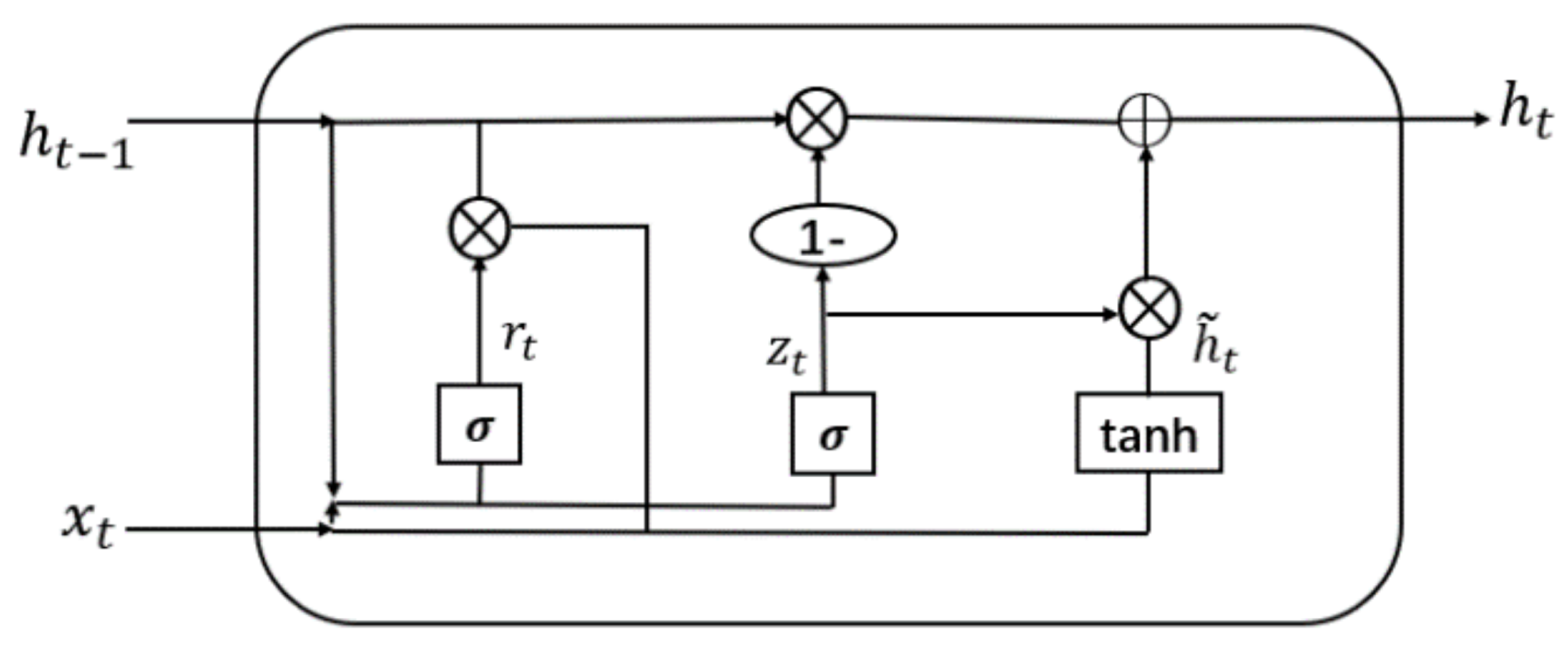
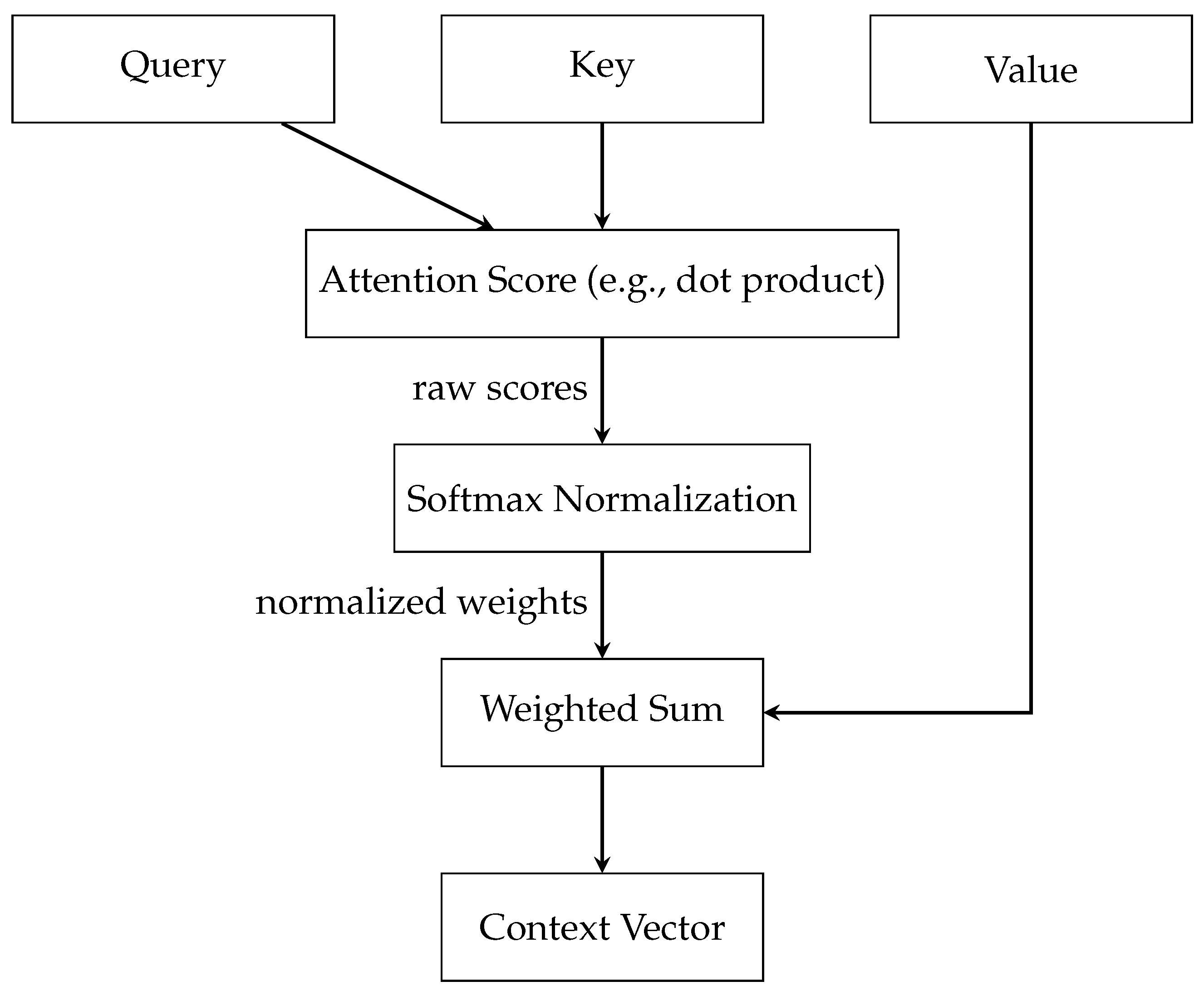

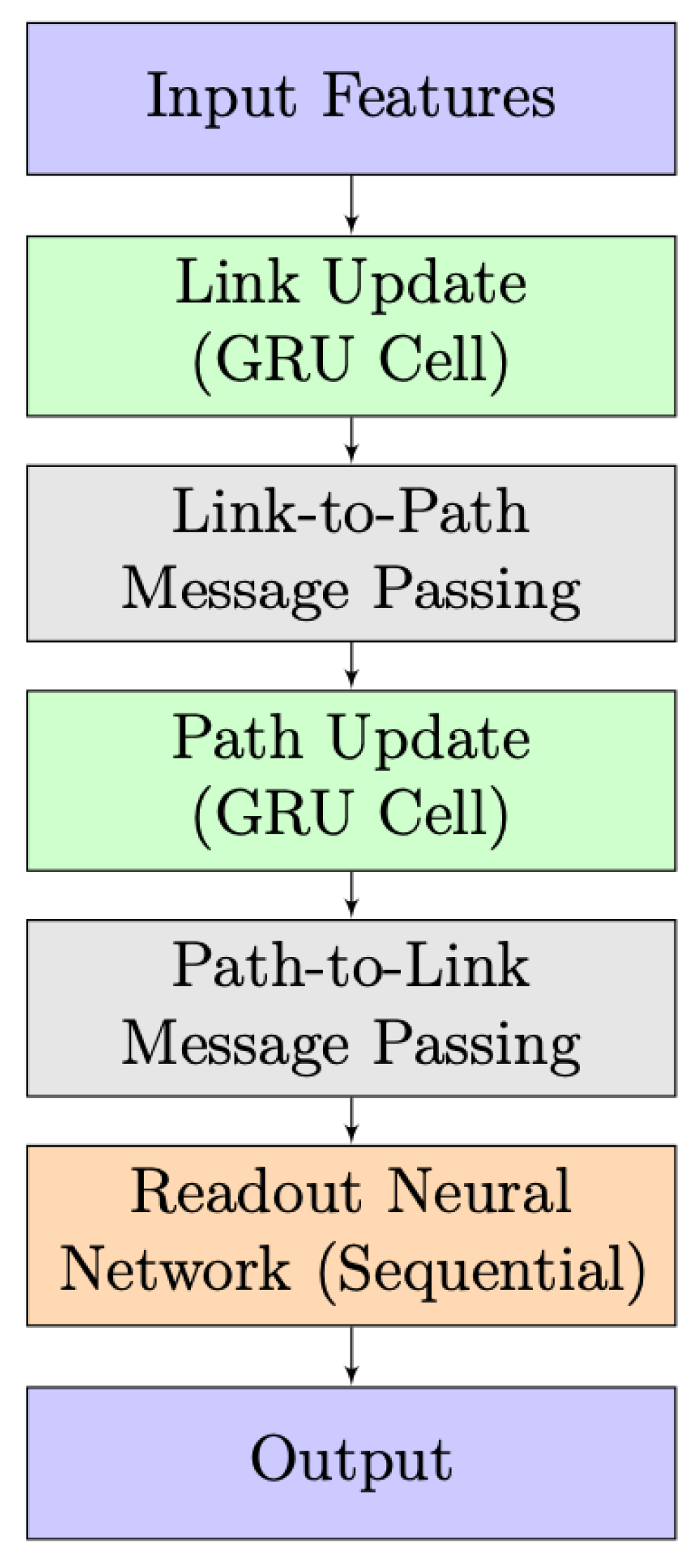



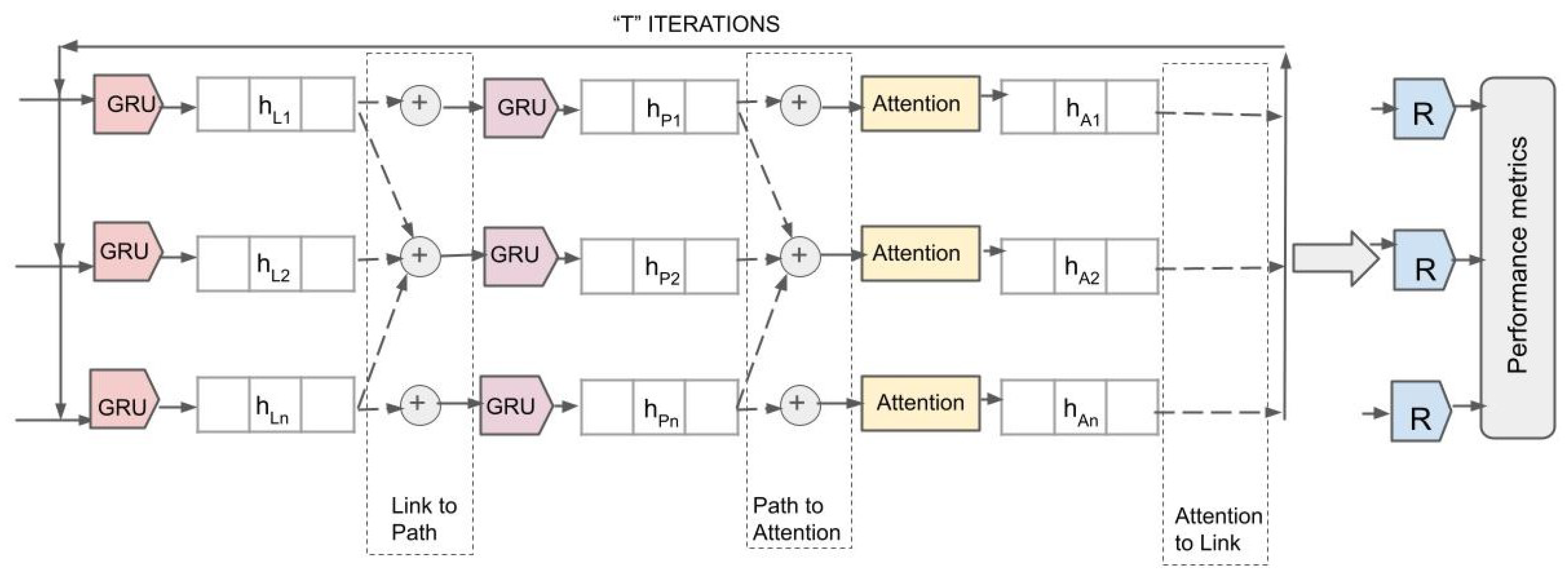
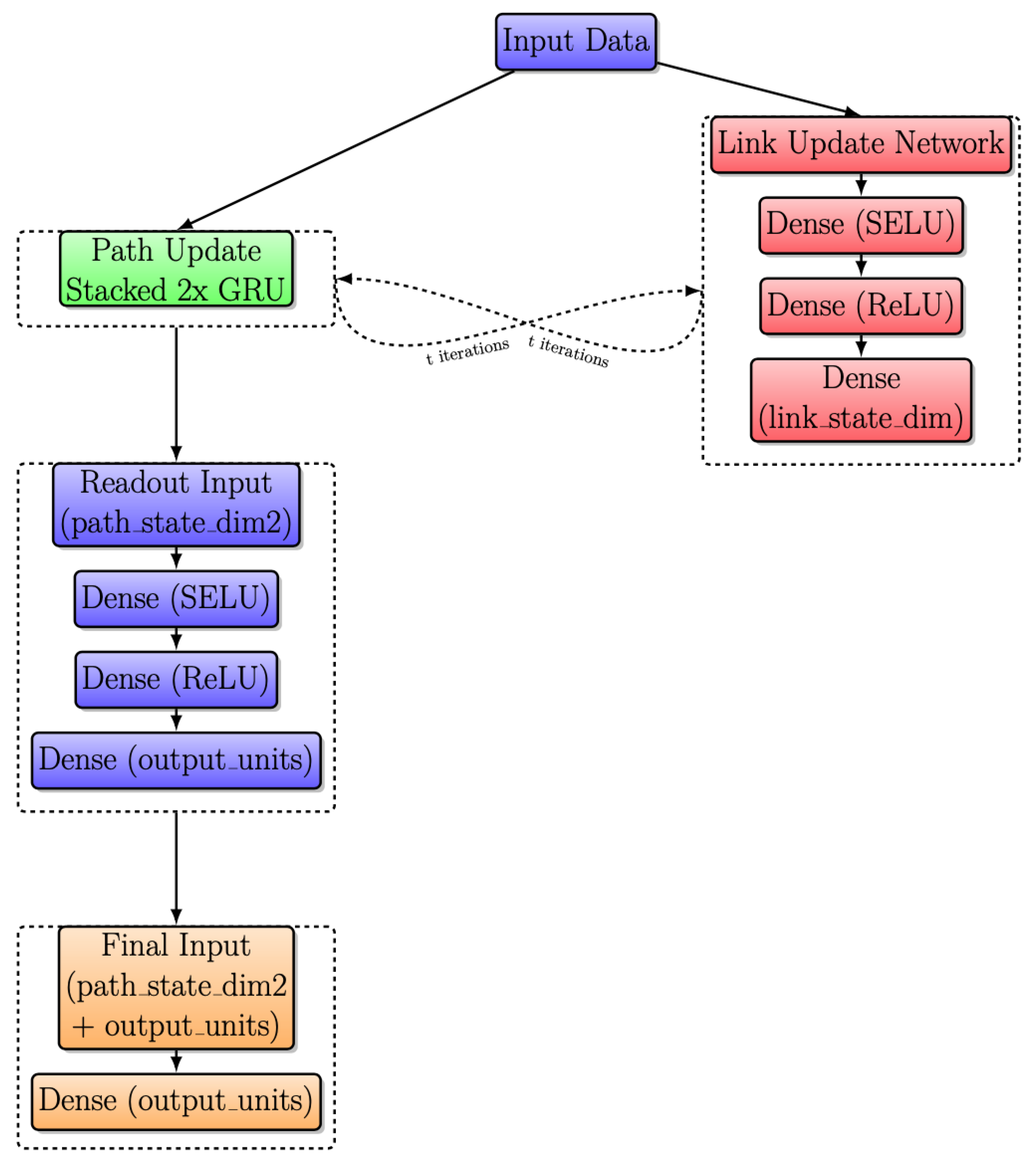



| Model Architecture | R² Value | MAPE Value (%) |
|---|---|---|
| Baseline RouteNet Model (Existing) | 0.8807 | 13 |
| RouteNet Model with Attention | 0.9574 | 2.4876 |
| Modified RouteNet Model (Existing) | 0.9695 | 4.9476 |
| Modified RouteNet Model with Attention | 0.9834 | 2.24887 |
Disclaimer/Publisher’s Note: The statements, opinions and data contained in all publications are solely those of the individual author(s) and contributor(s) and not of MDPI and/or the editor(s). MDPI and/or the editor(s) disclaim responsibility for any injury to people or property resulting from any ideas, methods, instructions or products referred to in the content. |
© 2024 by the authors. Licensee MDPI, Basel, Switzerland. This article is an open access article distributed under the terms and conditions of the Creative Commons Attribution (CC BY) license (https://creativecommons.org/licenses/by/4.0/).
Share and Cite
Dhamala, B.K.; Dawadi, B.R.; Manzoni, P.; Acharya, B.K. Performance Evaluation of Graph Neural Network-Based RouteNet Model with Attention Mechanism. Future Internet 2024, 16, 116. https://doi.org/10.3390/fi16040116
Dhamala BK, Dawadi BR, Manzoni P, Acharya BK. Performance Evaluation of Graph Neural Network-Based RouteNet Model with Attention Mechanism. Future Internet. 2024; 16(4):116. https://doi.org/10.3390/fi16040116
Chicago/Turabian StyleDhamala, Binita Kusum, Babu R. Dawadi, Pietro Manzoni, and Baikuntha Kumar Acharya. 2024. "Performance Evaluation of Graph Neural Network-Based RouteNet Model with Attention Mechanism" Future Internet 16, no. 4: 116. https://doi.org/10.3390/fi16040116
APA StyleDhamala, B. K., Dawadi, B. R., Manzoni, P., & Acharya, B. K. (2024). Performance Evaluation of Graph Neural Network-Based RouteNet Model with Attention Mechanism. Future Internet, 16(4), 116. https://doi.org/10.3390/fi16040116








